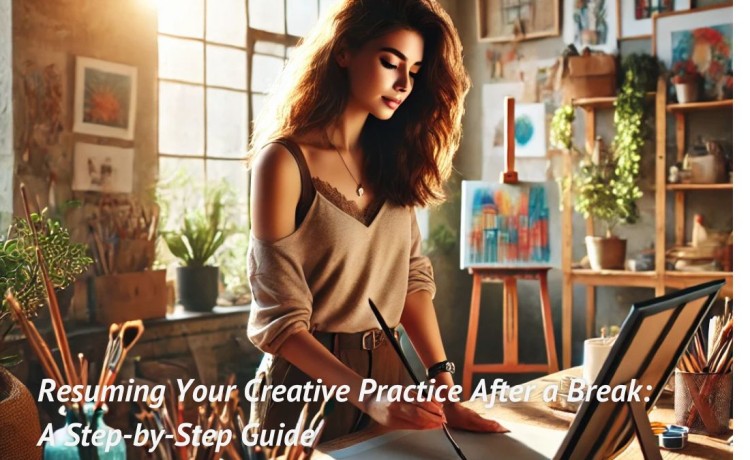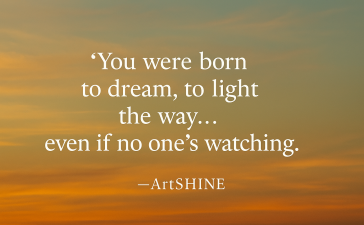In the world of creativity, taking a pause or stepping away from your work is often inevitable. Whether it’s due to family commitments, illness, maternity leave, a full-time job, or even the need for a holiday, life can sometimes pull you away from your creative projects. But when you return, you may find it challenging to pick up where you left off. The canvas you once approached with ease now feels unfamiliar, and the ideas that once flowed effortlessly now seem distant.
If this resonates with you, know that you’re not alone. Many creatives face this hurdle, and it can feel frustrating. However, this is part of the ebb and flow of the creative process, and there are ways to gently ease yourself back into your practice. This article will offer step-by-step suggestions to help you regain your creative momentum and reignite your passion for your work.
1. Acknowledge the Pause Without Guilt
The first step to getting back into your creative practice is to acknowledge the pause without guilt. Life happens, and it’s important to recognise that taking a break doesn’t diminish your identity as a creative. In fact, pauses can be essential for your mental and emotional well-being.
Guilt can be a major roadblock. It can create pressure and anxiety, making the return to creativity feel more like a burden than a joy. Remind yourself that it’s okay to have stepped away, and focus on the fact that you’re now ready to return. This mindset shift can alleviate the emotional weight that might be holding you back.
2. Set Small, Manageable Goals
When you’re ready to resume your practice, don’t rush back with unrealistic expectations. Jumping back in with grand, ambitious projects may lead to overwhelm and frustration. Instead, set small, manageable goals that allow you to gradually reintroduce yourself to the process.
For example, if you’re a painter, start with a small sketch or colour study. If you’re a writer, aim to write for 10 minutes a day rather than tackling an entire chapter. By breaking down your creative work into bite-sized pieces, you give yourself room to breathe and build momentum at a sustainable pace.
3. Revisit Past Work to Reignite Inspiration
Sometimes, the hardest part of returning to creativity is feeling disconnected from the projects you once loved. To help bridge that gap, revisit your past work. Take time to look through old sketchbooks, unfinished drafts, or previous designs. This can help you reconnect with your creative self and remind you of what inspired you in the first place.
It’s important to approach this exercise with curiosity rather than judgment. You’re not assessing the quality of your past work; you’re simply using it as a way to tap back into your creative flow.
4. Find New Sources of Inspiration
While revisiting past work can be helpful, it’s also crucial to invite fresh inspiration into your life. A period of pause often provides a new perspective, and now is the perfect time to seek out different experiences that can fuel your creativity.
Take walks in nature, visit art galleries, read books outside your usual genre, or listen to new music. The goal is to expose yourself to diverse ideas and environments that might spark a new creative direction. Sometimes, returning from a break can lead to an exciting evolution in your creative practice.
5. Create a Routine That Works for You Now
Your life circumstances may have changed since you last engaged with your creative practice. Perhaps you have new responsibilities or a different work schedule, and what worked for you before might no longer fit.
It’s important to create a new routine that aligns with your current reality. You might need to carve out smaller pockets of time for creativity or integrate it into other aspects of your life. For example, if you’re balancing family life, consider working during early mornings or late evenings. If you’ve returned to a full-time job, explore using weekends as dedicated creative time.
Remember, there’s no one-size-fits-all routine. It’s about finding what works best for you in this new chapter.
6. Embrace Imperfection and Experimentation
After a break, it’s easy to feel that your skills are rusty or that your work doesn’t meet the standards you once set for yourself. This is completely normal. Creativity, like any other skill, needs time to rebuild.
Instead of striving for perfection right away, give yourself permission to experiment and make mistakes. Use this time to play with different techniques, materials, or ideas. By releasing the pressure to create a masterpiece, you open up space for genuine exploration and growth.
7. Celebrate Small Wins
Every step you take towards resuming your creative practice is a victory, no matter how small. Celebrate these moments of progress, whether it’s completing a sketch, writing a paragraph, or simply spending an hour working on your craft.
Acknowledging your achievements can help you stay motivated and remind you that progress is being made, even if it feels slow. Each small win brings you closer to regaining your creative rhythm.
8. Seek Support and Community
Creativity doesn’t have to be a solitary endeavour. Surround yourself with supportive people who understand the challenges of resuming a creative practice after a break. This could be fellow artists, writers, designers, or any other creatives who have faced similar struggles.
If you don’t have a support network in place, consider joining an online community or local creative group. Sharing your experiences, discussing your work, and receiving encouragement from others can be incredibly uplifting and may help you stay accountable to your goals.
9. Be Kind to Yourself
Above all, be kind to yourself. Resuming your creative practice after a break can be challenging, and it’s okay to feel frustrated or uncertain at times. Remember that creativity isn’t a race, and there’s no deadline to “get back to where you were.”
Allow yourself the grace to move at your own pace and trust that, with time and persistence, you’ll find your way back. Your creative journey is uniquely yours, and every step you take brings you closer to rediscovering the joy and fulfillment that creativity brings.
In conclusion, resuming a creative practice after a break can feel daunting, but it’s entirely possible with patience, self-compassion, and a gradual approach. By setting small goals, finding inspiration, creating a new routine, and embracing imperfection, you can slowly rebuild your creative momentum. Remember, you’ve already made the first important step: you’re ready to return. Trust in your process, and the creativity will follow.
- Find out more
- Launch Pad + Accelerator Expressions of Interest
- Selling and Licensing Your Art & Designs Around the World with ArtSHINE.
- Looking for exciting new Art and Designs to license.
We’re here to help you to take action, just like we’ve helped thousands of other entrepreneurs, business owners, and creative professionals all around the globe.
Now is the time to let your passion SHINE.
Now is the time to Make Tomorrow Today!
To your success, Vinh Van Lam and Stuart Horrex Cofounders ArtSHINE.com





